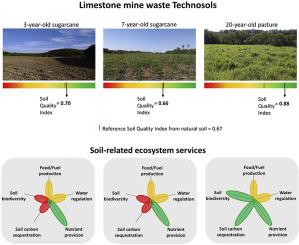Journal of Environmental Management ( IF 8.7 ) Pub Date : 2020-09-12 , DOI: 10.1016/j.jenvman.2020.111344 Francisco Ruiz 1 , Maurício Roberto Cherubin 1 , Tiago Osório Ferreira 1

|
Mine reclamation has long relied on reusing topsoil to mitigate mining impacts but recently constructed soils (i.e., Technosols) have emerged as novel technologies for restoring post mining landscapes. However, their success depends on their ability to sustain soil functions. To assess the efficiency of a limestone mine reclamation, we measured the soil quality (SQ) of a three- (SC3) and seven-year-old (SC7) Technosol under sugarcane, and one 20-year-old (P20) Technosol under pasture, constructed with limestone spoil in southeastern Brazil. Soil chemical, physical, and biological attributes were evaluated and compared with those of an adjacent natural soil (NS; Rhodic Lixisol). We also tested the Soil Management Assessment Framework (SMAF) for assessing the SQ of the studied soils. SMAF was suitable to detect SQ changes over the years of reclamation. After three and seven years under sugarcane cultivation, the Technosols showed similar SQ indexes (= 0.70 and 0.67) to that of the native soil (SQ = 0.69), whereas after 20 years under pasture the SQ (= 0.88) of P20 was superior to that of NS. Overall, the Technosols recovered most of the ecosystem services expected for healthy soils, especially in P20, where carbon stocks were 2.7 times higher than in NS (82.1 vs 30.35 Mg C ha−1). We highlight the importance of using soil quality assessment tools, such as SMAF, in mine reclamation. In summary, Technosols from limestone wastes could restore basic soil functions under tropical environmental conditions within only 20 years.
中文翻译:

人工建造的Technosols的土壤质量评估:旨在验证一种有前途的土地开垦,废物管理和土壤功能恢复策略。
长期以来,矿山开垦一直依赖于表土的再利用来减轻采矿的影响,但是最近建造的土壤(即Technosols)作为恢复采矿后景观的新技术而出现。但是,它们的成功取决于它们维持土壤功能的能力。为了评估石灰石矿山复垦的效率,我们在甘蔗下测量了三(SC3)和七年(SC7)的Technosol的土壤质量(SQ),在蔗糖下测量了二十岁(P20)的Technosol的土壤质量(SQ)。牧场,在巴西东南部用石灰石土建造。对土壤的化学,物理和生物学属性进行了评估,并与相邻的天然土壤(NS; Rhodic Lixisol)进行了比较。我们还测试了土壤管理评估框架(SMAF),以评估研究土壤的SQ。SMAF适用于检测填海多年中的SQ变化。在甘蔗栽培下三到七年后,Technosols的SQ指数(分别为0.70和0.67)与本地土壤的SQ指数(SQ = 0.69)相似,而在牧场下20年后,P20的SQ(= 0.88)优于NS的。总体而言,Technosols恢复了健康土壤所需的大多数生态系统服务,尤其是在P20中,那里的碳储量是NS的2.7倍(82.1 vs 30.35 Mg C ha-1)。我们强调在开垦中使用土壤质量评估工具(如SMAF)的重要性。总之,石灰石废料中的Technosols只能在20年内在热带环境条件下恢复土壤的基本功能。


























 京公网安备 11010802027423号
京公网安备 11010802027423号